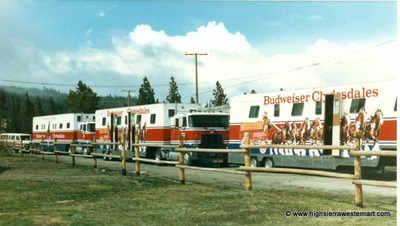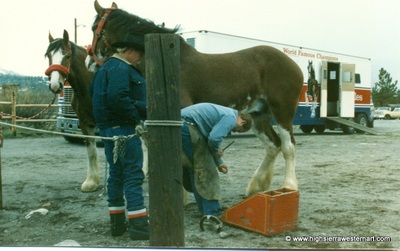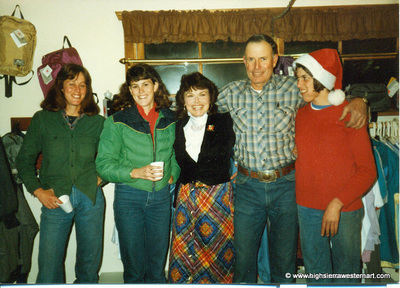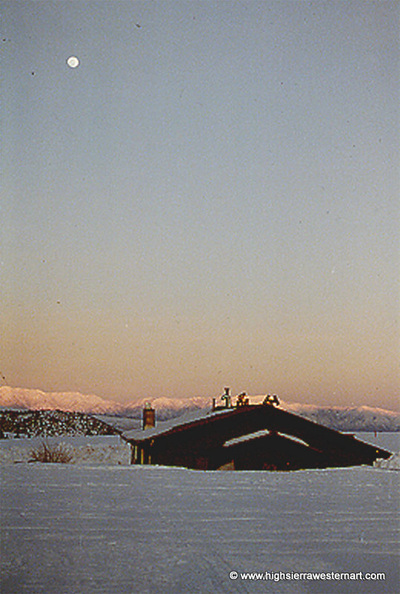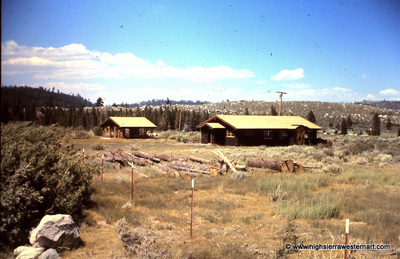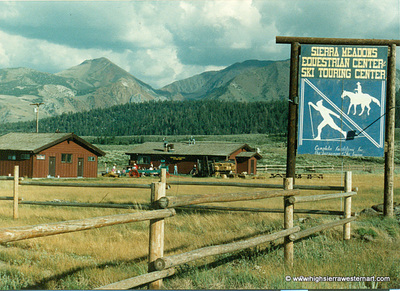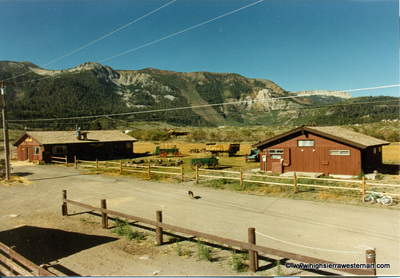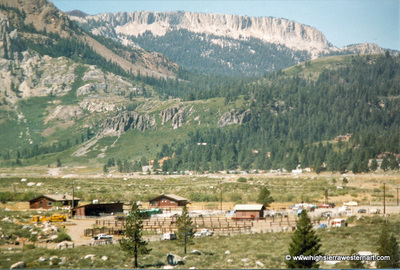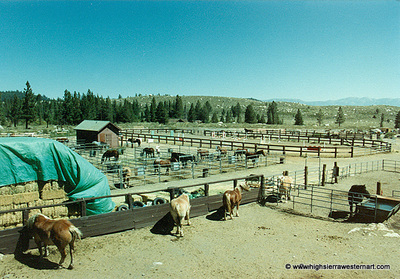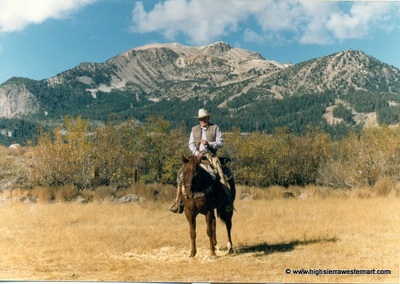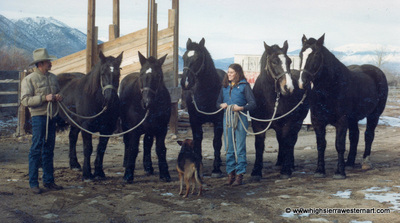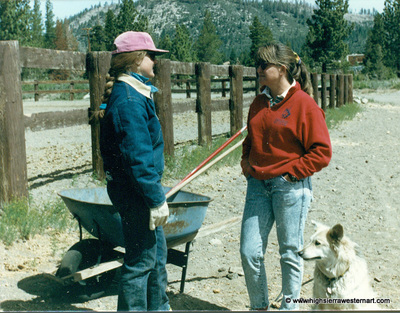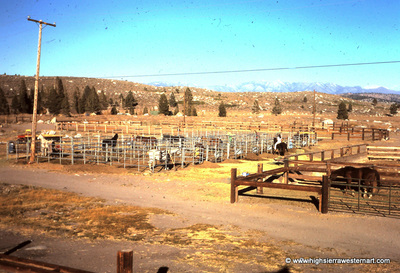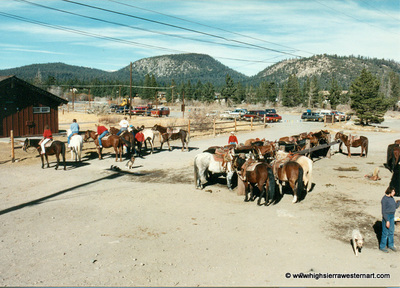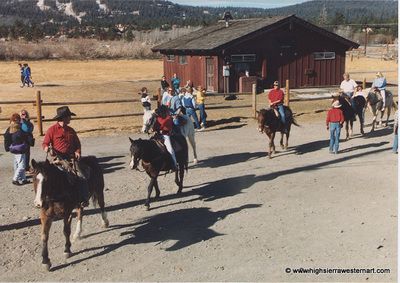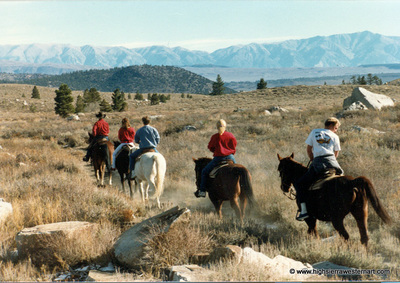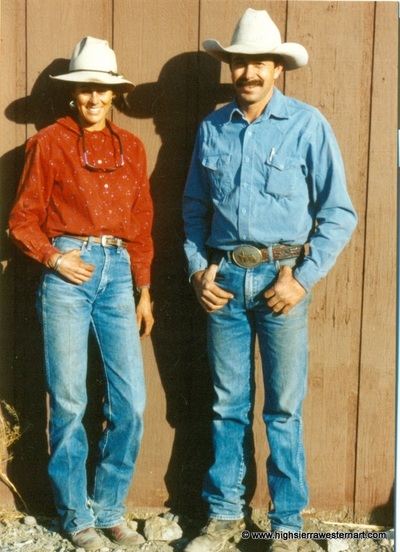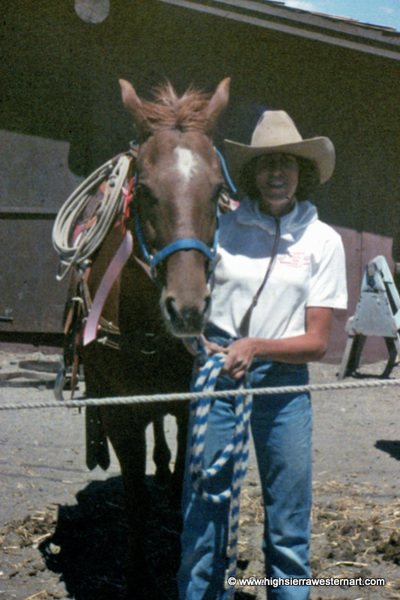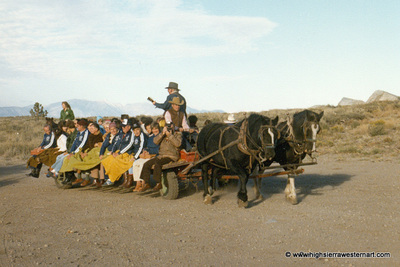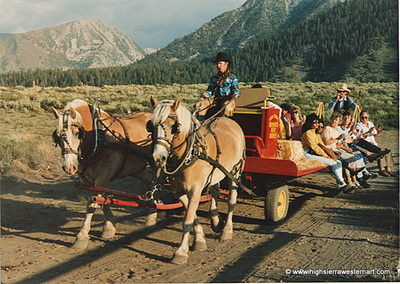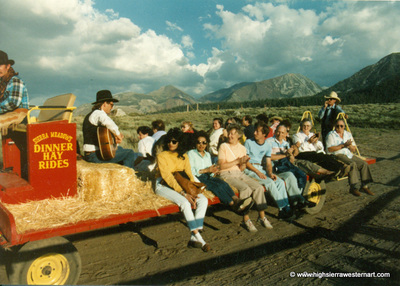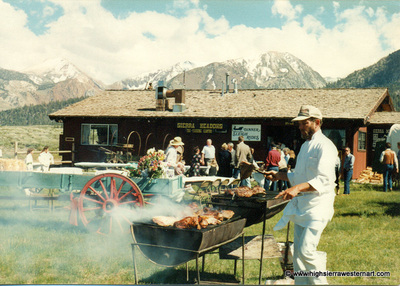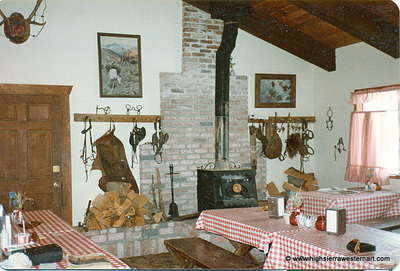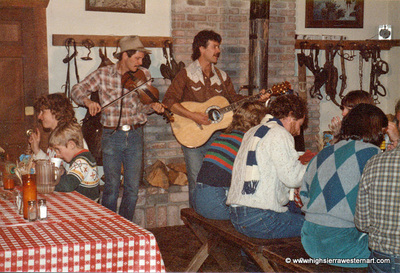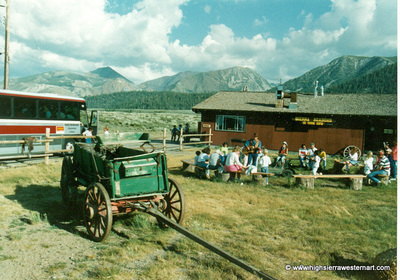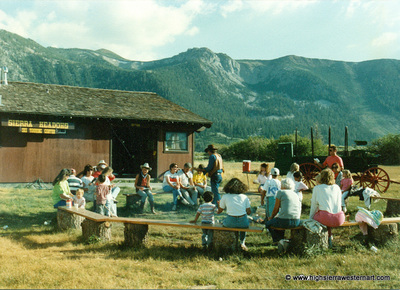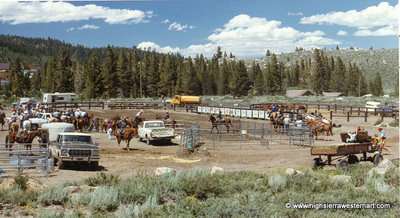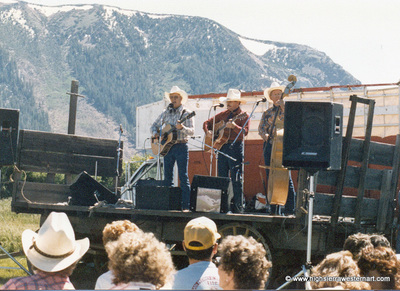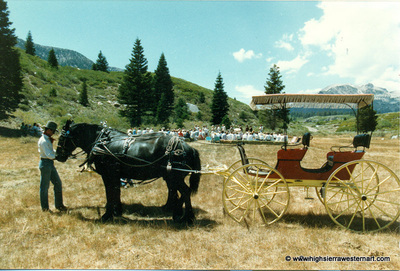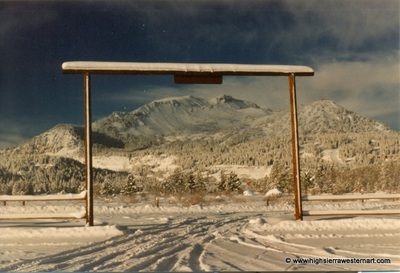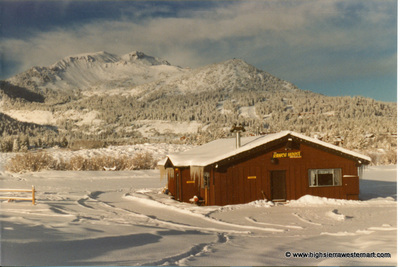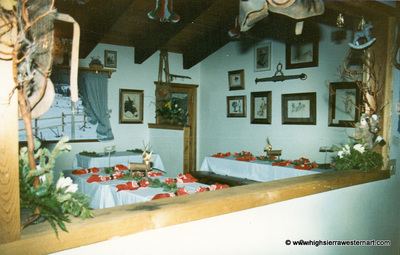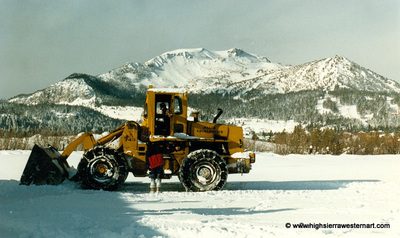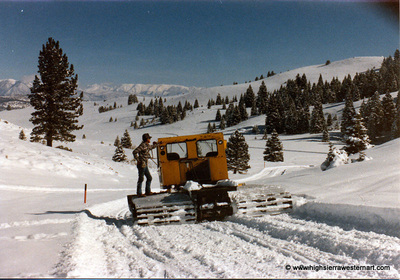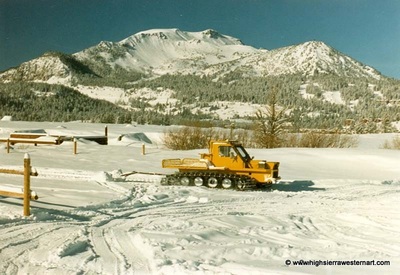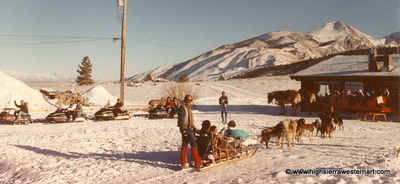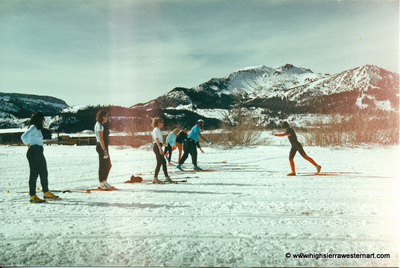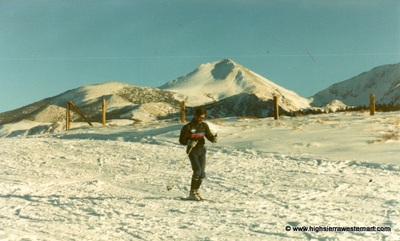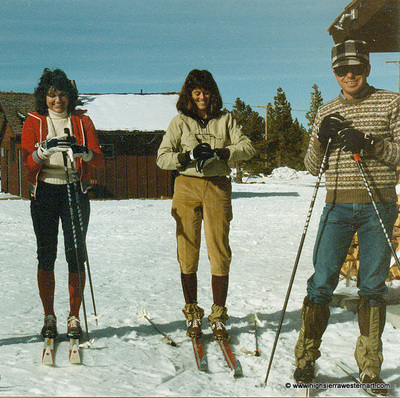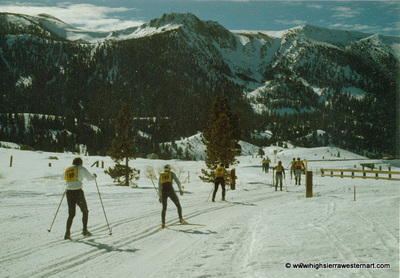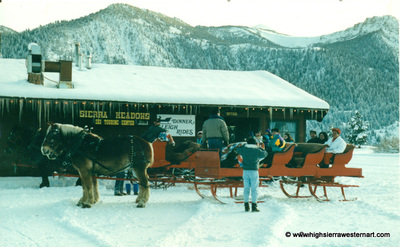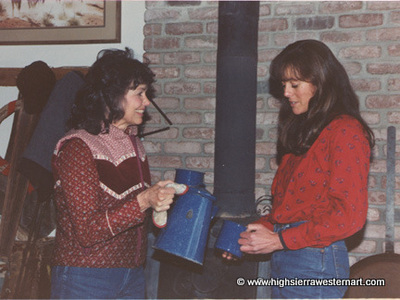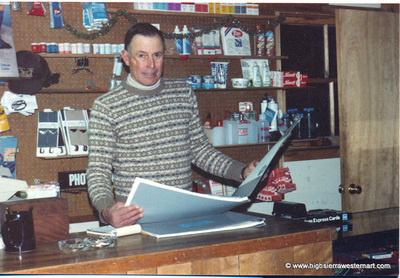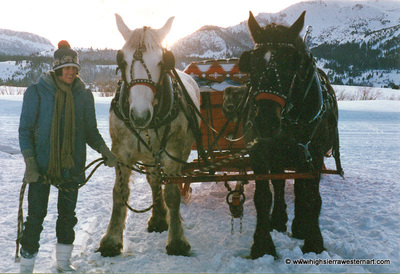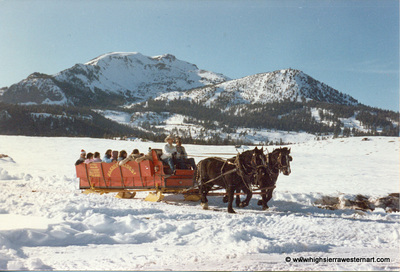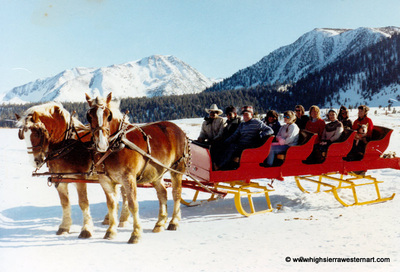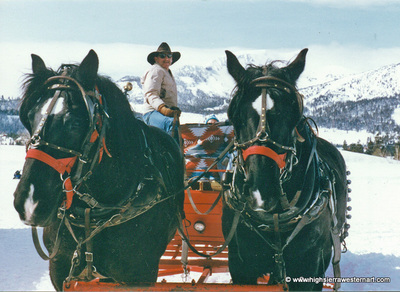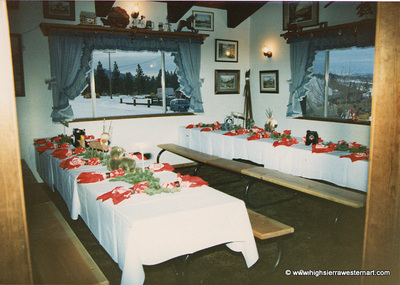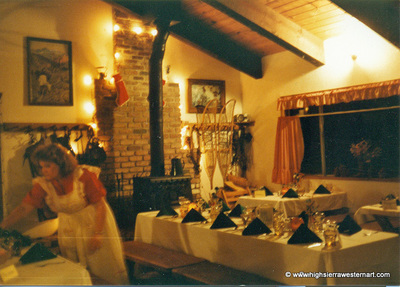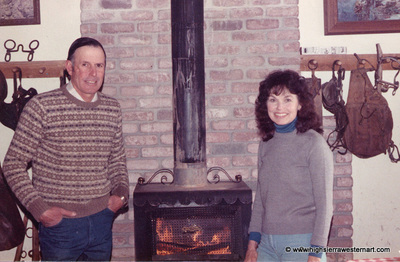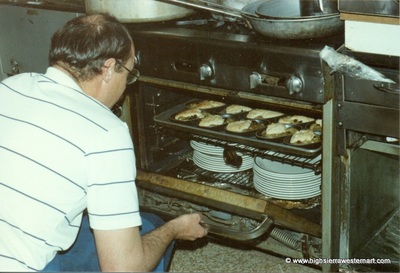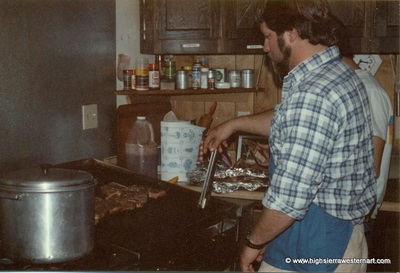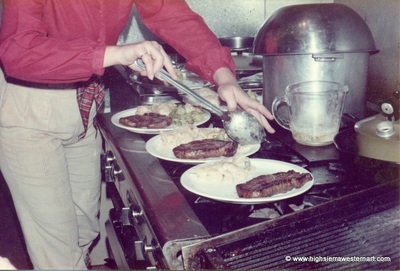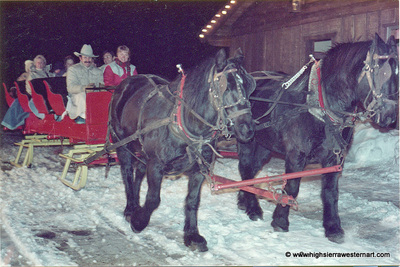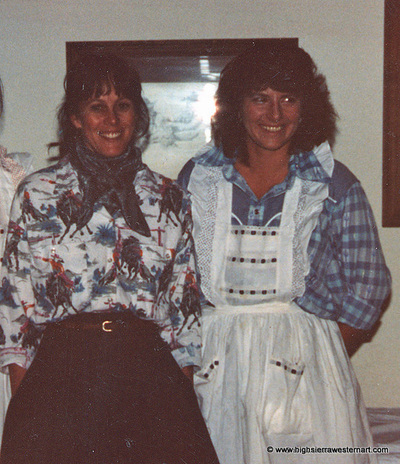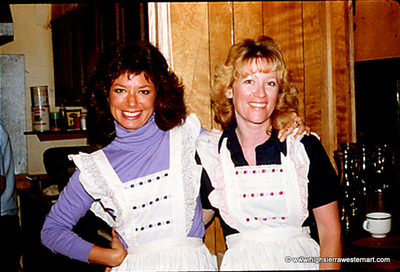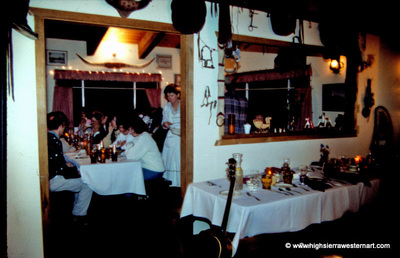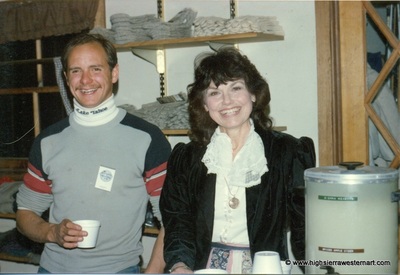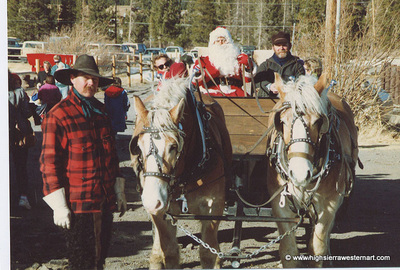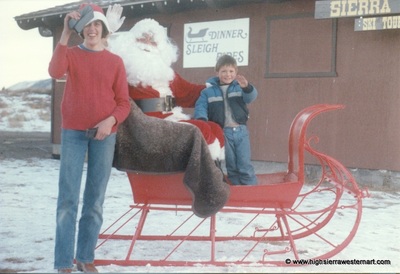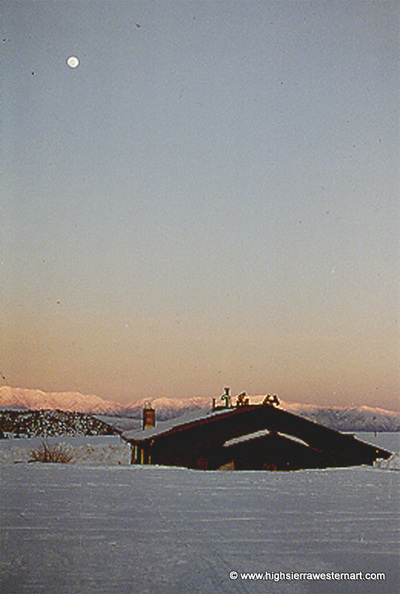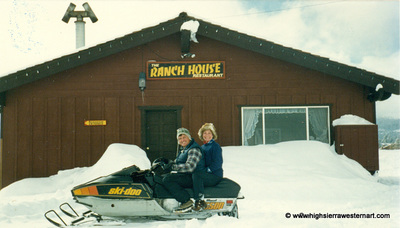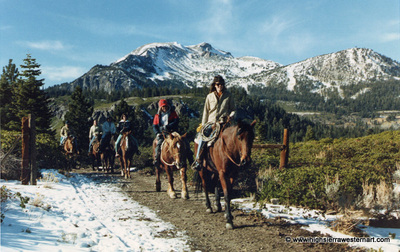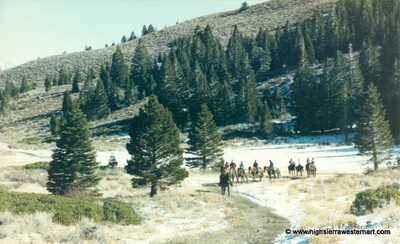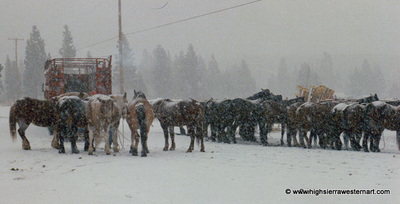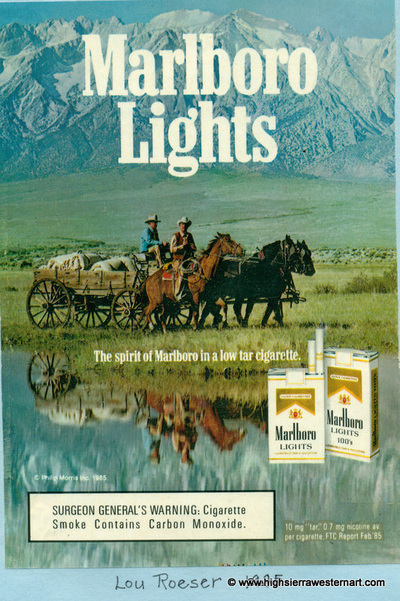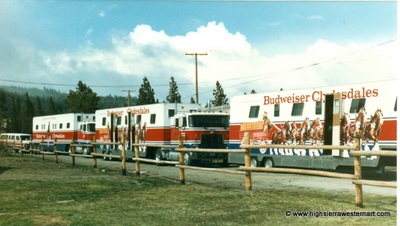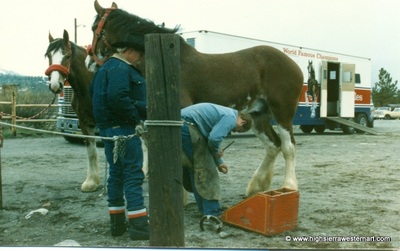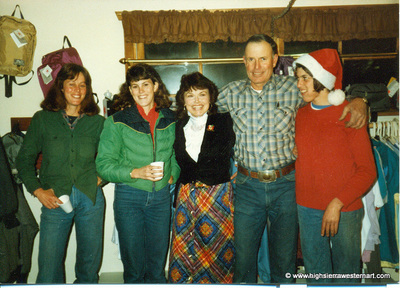Sierra Meadows – A Magical Place in Time
by Marye Roeser
|
In the summer of 1965, Lou Roeser was working as a wrangler and livestock contractor supplying horses and mules to Paramount Films during the filming of the movie “Nevada Smith”, in Mammoth Lakes, CA. During this filming, Roeser spent much time in the eastern part of the Mammoth Meadows. Crews had constructed an old western town for filming the movie. The town, including a general store, livery stable, saloon and town hall, was quite authentic looking but would soon be torn down after the end of the filming according to the agreement with the Forest Service. Lou kept noticing a parcel of pasture land across the Sherwin Creek Road that appeared to have possibilities. The meadows were irrigated and grassy.
Just to the south of this site were the old Rodeo grounds that had also been used as baseball fields for the local teams. Tom and Carrie Wonacott of Bishop had operated a dairy in the 1920’s and 30’s supplying milk and butter to the campers, residents and the hotel in the Old Mammoth area. The area was part of what was referred to as Mammoth Camp during those early years but called Old Mammoth today. Tex Cushion had maintained a malamute dog team on the Old Mammoth Road beginning in the 1920’s until after World War II. He had provided winter transportation by dog sled in the area and even supplied the Minaret Mines in the Ritter Range, a difficult far distant haul. Beginning in 1966, dog sled races were held in the meadows on the south side of the Old Mammoth Road for several years. Snowmobile races soon followed on the north side of the road. Lou Roeser had a dog team during the winters of 1965 to 1967 and he trained his mostly young malamute dog team out in the lower meadows. This was an area that could provide both winter and summer activities. In the winter, sleigh rides and Nordic skiing was possible as well as dog sled rides. Lou had been looking for a site where there could be a horse boarding operation. At the Mammoth Lakes Pack Outfit, that he owned and operated, he was able to board only a very few outside horses, due to a lack of boarding facilities and a short season. In addition, hayrides could be offered in a country setting. H was running early evening hayrides from the station to Horseshoe Lake for a campfire with hot chocolate and a marshmallow roast. However, with increased traffic on the Lake Mary Road, the narrow road with little shoulder space and a slow moving wagon presented some worries. The Mammoth Lakes Pack Outfit conducted pack trips to the Sherwin Lakes and Valentine Lake and over Laurel Pass to the lakes above Convict Lake. An additional headquarters nearer to those trailheads would ease trailering stock to them. In 1967, Roeser approached Joe Radel, Supervisor of the Inyo National Forest, with a proposal for a year round horse operation location in the area. The chosen thirteen acre parcel on the east side of the Sherwin Creek Road had been used for pasture, and was partially fenced and irrigated. The Forest Service approved his application and issued a twenty year permit for the development in 1968. Lou also acquired a grazing permit and a site for the hayrides and dinners in Kerry Meadow and the Hidden Lake Meadow from the Forest Service. He began drawing plans for the new site and the lodge building and acquired a Mono County building permit. The Arcularius Ranch private property was sold to Mammoth Sports, Inc. in the late 1960’s. The ranch was adjacent to our new site on the west side of the Sherwin Creek Road. Lou was able to pasture horses on a portion of the ranch in the spring and the fall. In 1969, he began building the new lodge building. It was two stories with a loft. In 1970, the building was closed in and ready for the interior work during the winter months. During that heavy winter, Lou worked for Bob Schotz during the day, on a Condo project off the Old Mammoth Road, and evenings and week-ends worked on finishing work in the lodge. Tools, materials, furnishings etc. were all stored inside the building when winter arrived with deep snows. After a heavy snow in January, 1971, Lou had the road in plowed out so that a propane truck could drive in to refill the propane tank next to the lodge. It was snowing again and Lou’s bedroom was on the second floor. After telephoning to the winter family home in Coleville many times and not reaching anyone, he became concerned and decided at 9 PM to drive home, a two hour or more drive in the snow. Upon arriving home after 11 PM, he was relieved that all was well; a Reno doctor appointment trip followed by a 4-H Meeting had kept the family out. At about 1 AM, the Sheriff’s Department called, and were thankful when Lou answered the telephone. But, the deputy sadly reported that the lodge building had just burned to the ground from what appeared to be a gas leak explosion. We were stunned with the news. So much effort and hard work had disappeared in the hot fire, and we would have to start all over again. But, such a miracle, that Lou had decided at 9 PM that night, to drive home to Coleville in a snowstorm, because he was worried about his family! That summer, Lou began rebuilding the lodge on the same foundations, this time with a one story building. In 1972, he began construction on what would be a barn and wagon and sleigh storage just to the north of the lodge. Construction began on corrals, an arena and a small barn and saddle room. In 1973, we began hayrides in the meadow with our hay wagon that Lou had built in 1960 and pulled by the draft horses Red, Blue and Blackn’. These original horses were followed by a series of wonderful percheron and Belgian gentle giants. Lou or Jim Heavens drove the hay wagon out to the Meadow where Lou had built a large campfire circle with benches. We served hot chocolate and roasted marshmallows while singing all the old camp songs. Until the barn and corrals were finished, they hauled the draft horses down to the “new site” in the horse trailer for each hayride. The hay wagon was parked there. If any pack station employees played the guitar or harmonica, they were drafted to accompany the sing a longs. What to call the “new site” seemed a difficult decision and many names were floated until we finally decided upon Sierra Meadows Equestrian Center. The Ski Touring Center was added later. In 1976, Arnie and Susan Metcalf became working partners at Sierra Meadows. We held a Grand Opening Celebration of Mammoth Outfitters (An early name) at the beginning of the summer season. We began serving hayride BBQ dinners out in the Meadow with Dan and MaryAnn Farris doing the delicious dinners. We had many senior citizen and British Isles bus tours, staying at various lodges in Mammoth Lakes, arranging for the hayride dinners and we added professional musicians to play the sing a long musical entertainment. That winter, we opened the Ski Touring Center with lessons, a rental shop and small retail shop. The rental shop crew fitted skis and boots to each individual and kept the skis waxed and ready to use. Cross Country ski tracks needed to be set around the meadow area. An expert Nordic skier would ski the tracks in originally until we acquired a snowmobile with a tract setter to set the Nordic ski tracks. The area in front of the lodge became the teaching area and many skiing lanes were set across the flat. Instructors conducted classes there and when students were ready to go out on the ski tracks through the snow covered meadows and hills, they followed their instructors. More boarding pens were added as well as a 2nd arena. We added a string of horses and conducted guided hour, two hour and half day rides. We had a horse brand designed for the saddle horses that stood for a mountain and a meadow describing Sierra Meadows. Through their contacts, the Metcalfs conducted retreats for church youth groups from the southland throughout the year that headquartered at Sierra Meadows enjoying both winter and summer activities. The second building that Lou had been planned to be a horse and wagon barn was now needed for housing. It was remodeled into the bunk house. The hayride meadow was also used for weddings, reunions, going away parties and was officially named Kerry Meadow after our daughter, Kerry. Sierra Meadows Equestrian and Ski Touring Center was a very busy place. In 1976, the Mammoth Lakes Pack Outfit conducted our first Fall Horse Drive beginning at Sierra Meadows and ending at our 5,000 acre Independence pasture. We took guests who helped the crew drive the pack station horses and mules, and Sierra Meadows saddle horses and camped along the 100 mile route. The following spring, we added a spring Horse Drive. The Spring and Fall Horse Drives became an instant success and we staged them from Sierra Meadows each year. In 1981, the Metcalfs left Sierra Meadows for health reasons; moving back to Southern California and Lou hired managers that year. He had not yet added the sleigh ride portion of his dream for Sierra Meadows, but had been researching other sleigh ride dinner operations. In the fall of 1982, Lou began building the needed facilities for this new activity. With the help of some of the talented pack station crew, they added additional space onto the barn with stalls, heat lamps, harness storage and enlarged the corrals to accommodate several teams of draft horses. He purchased two used sleighs that he revamped for our operation. The crew also remodeled the kitchen into a restaurant kitchen and the two dining rooms were equipped with tables and benches for family style, hearty meals. The dining rooms were called “The Ranch House”. Lou took over the “Cowboy Condo” portion of the bunkhouse for our family apartment. Other staff members lived on the other side. Lou was able to purchase three used snowcats from Mammoth Mountain Ski Area for setting ski trails and plowing snow. Tractor Loaders were needed to plow the parking lot, the road into the lodge and from the entrance to the parking lot on the Sherwin Creek Road to where it joined the Old Mammoth Road. The County of Mono plowed the Sherwin Creek Road portion to our entrance when they had time, but it wasn’t their first priority. Lou also had to plow the sleigh route. When the snow was deep and soft, the sleighs could get stuck. Even after he plowed the route, the strong winds across the flat would drift in soft snow. He had to pack the deep snow on the route so the horses could pull the sleigh and the runners would glide easily along on the packed snow. |
Sierra Meadows Photo Gallery
|
By Thanksgiving in 1982, we were ready to open for our first Sleigh Ride Dinner. We cooked and served a turkey Dinner with all the trimmings, Fiddlin’ Pete from Bishop provided the musical entertainment and the event was a great success. There was much interest in town and reservations for the holidays began coming in.
Lou knew that we needed more draft horses. Shortly before the Christmas holiday, he accompanied by our daughter, Leslie, on her college break from Cal Poly at San Luis Obispo, drove to Albany, Oregon to look at horses. He purchased five big, black percheron draft horses – Little Prince, Big Prince, Streak, Dudley and Esther. Returning through a heavy snow storm was slow traveling, and when the road closed they pulled into a fairground where the horses enjoyed snug stalls. But, they reached home in Coleville, just before Christmas. Those horses were true workhorses, eager to be harnessed to the sleigh, energized by the sound of the sleigh bells and beloved by all who worked with them.
We planned a menu choice of grilled steaks or stuffed chicken breast. With that we served French Onion soup, scalloped potatoes, mixed cauliflower/broccoli vegetables with a garlic lemon butter sauce, dinner rolls and a pumpkin crisp for dessert. “Mmm! Lou, Lee, and Dan drove the teams pulling sleighs that were piled high with warm blankets. In winter, the visitors have wonderful warm ski togs to wear and with the blankets, they were toasty warm. All of our family helped with the operation. Fiddlin’ Pete provided lively fiddle music and Christmas carols were sung by all.
After the holidays, winter weather closed in quickly with many snow storms that soon became one of the heaviest winters on record in Mammoth Lakes. Suddenly, on the eve of January 6, 1983, (during a sleigh ride dinner) a large earthquake hit – 6.1 and it was centered just to the south east of Sierra Meadows near Sherwin Creek. This was only two years after Mt. St. Helens had erupted in May of 1980 and there was genuine fear by geologists that Mammoth Mountain or other hot spots in the Long Valley caldera were about to erupt. Mammoth Mountain is an inactive volcano and there was fear that it was becoming active again. Geologists poured into Mammoth Lakes from all over the country to study this event while the skiers and winter visitors just as quickly left town. Someone with a sense of humor tacked up a sign on the outskirts of Mammoth saying, “Last person out of town turn out the lights”.
Lou and his snowcats, however, were in much demand. The geologists, volcanologists and scientists needed access to the epicenter and all the other selected spots to be studied, and their instruments set up. The aftershocks continued.
The snow also continued to fall, and it was difficult to keep the cross country trails open, the teaching lanes packed, and everything plowed. There still were visitors who traveled to Mammoth for their winter vacations to ski and go on sleigh rides. The snow was 6 feet deep the rest of the winter and the crew shoveled steps down into the buildings. The sleighs went as often as possible and the staff produced delicious dinners.
In between storms, the sun shone on a gorgeous white world of powder snow and the skiing was wonderful. The draft horses had grown thick, shaggy coats and did not seem to mind the snow or the cold temperatures. During the day, even when it was snowing, they preferred to be outside in their corral rather than in the heated barn.
I drove to Sierra Meadows on weekends when weather allowed as I taught school during the week at Antelope Elementary School and art at Coleville High School. I was also teacher in charge of the schools’ downhill ski program and we had School Ski Day at June Mountain Ski Area one day a week. I rode on the school bus with the elementary and high school students for a great day of downhill skiing on copious depths of snow.
Spring finally arrived and the snow eventually melted and it was time to switch from winter activities to summer season activities. This pattern of labor occurred each spring whether it was a mild winter or a heavy winter with a late spring. The skis were inventoried and put away for next season. Sleighs were parked and the hay wagon was dusted off and maybe repainted. Boarding pens were set up and readied for the boarders. We had long term boarding pens in one section and short term boarding pens in another. Saddles and bridles were oiled. The two arenas and small round corral were dragged and corral boards repaired if necessary. The water system for the boarding areas was activated, turned on and hoses organized. Saddle horses were hauled up from winter pasture. If the saddle horses came up with the Horse Drive, they were already shod. If not, they had to be shod, their manes and tails combed, and winter coats brushed away.
In the lodge, the office staff was busy scheduling upcoming hay ride dinners, the Horse Drive with the Mammoth Lakes Pack Outfit and reservations for pack trips. In June, the Horse Drive left Independence and five days later reached Sierra Meadows. The mules and extra horses were put in the Hidden Lake pasture and the saddle horses for the pack station were ridden up the Mammoth Rock Trail to the Lakes Basin. The pack station began a busy summer season of pack trips and trail rides.
Summer was here and it was again time for hay wagon rides and dinners in the late afternoon and evening. Fiddlin’ Pete and Derik Olsen provided music and songs on both the hayrides and the sleigh ride dinners. We had built a fire circle with benches between the lodge and the bunk house for a sing-along and marshmallow roasts. During the day, guides conducted visitors on scheduled hour and two hour guided trail rides on the surrounding trails. The crew fed and watered the horses along with all the boarded horses twice a day and the pens were cleaned.
In about 1985, Lou purchased Mammoth Snowmobile Rentals. With the string of machines, we conducted guided rides out in the flats toward the Inyo Craters. This was an area of good dependable snow and miles of trails that Lou packed with a snow cat. It was very popular with winter visitors who wanted to break up their ski days. The Alaskan dog team rides operation was at Sierra Meadows on weekends and holidays. They used the plowed sleigh ride route for their dog sleds during the day.
From 1985 to 1988, we held Old West Days at Sierra Meadows over the Fourth of July holidays and that was a very popular event for visitors and residents alike. At the same time, we hosted a California Carriage Club Show with a judged show competition. The participants finished their show events with a lunch ride down the Mammoth Creek Road to a lovely creek side meadow. Lunch baskets with a gourmet picnic and blankets to lounge on made a balmy summer day complete. Lou and I led the “parade” of buggies and wagons with our bright red surrey with the fringe on the top, and pulled by Lou’s sorrel mule team of Jack and Jill. Returning through Mammoth Lakes, we drove down the Old Mammoth Road with police cars and flashing lights to the front and rear of the carriage parade, and that was a treat for visitors. The Club also participated in the 4th of July Parade. The annual Mammoth Lakes 4th of July Parade began at Sierra Meadows parking lot and continued into town.
Other Old West Days activities at Sierra Meadows included a ranch roping and branding event in the big arena, a western music concert show, square dancing, hayrides, BBQ hamburgers and hotdogs. One year, we conducted an overnight wagon ride down to the Chance Ranch in Long Valley with a delicious BBQ dinner featuring Dutch oven cooking and a western music concert by members of The Reinsmen musical group.
The ski trail system grew and we expanded our lessons. Lou purchased a large groomer and track setter to pull behind a snowcat so that we set traditional tracks and a groomed area for ski skating that was becoming very popular. We put on Nordic ski race competitions and Australia Days when we had an Australian heading up our Cross Country Center.
The years rolled by and Sierra Meadows continued to expand activities. I took early retirement from my teaching position in Coleville to help more with our Mammoth Lakes businesses.
The lodge was cozy and warm with a wood stove and we served hot homemade soups and French bread for lunch. A buffet table was set up with two crock pots of soup, and a dessert of the cook’s choice. Hot coffee, steaming cocoa and tea were always available along with soft drinks. On Sunday mornings, we had a delicious brunch set up. The sleigh rides only began at 5 PM and the sleigh ride dinners began at 6 PM. Large coffee urns were set up in a lodge room with one of hot spiced wine and one of hot apple cider for the guests while checking in and waiting for their sleighs. The sleighs were driven up to the entrance and guests were tucked in with warm blankets. With a jingle of sleigh bells and the command, “Let’s Go” from the sleigh drivers, the sleighs were off. On their return, guests were ushered to the dining rooms for seating while Pete and Derik played the fiddle and guitar respectively. Our menu changed somewhat from year to year but we offered a choice of prime rib, baked chicken, or grilled trout and a hearty family style dinner. It was a fun evening for all ages.
Originally, the hayrides offered dinner out in Kerry Meadow. Guests rode the hay wagon out to the meadow where dinner was served. Pete Wickersham provided the musical entertainment and guests sat around the campfire, roasted marshmallows and sang. After we remodeled the kitchen and dining rooms in 1982, we served the dinners in the dining rooms or outside on the lawn. The hay wagon ride still went out to Kerry meadow and the musician accompanied it with guests singing on the wagon. After dinner in the lodge, we had a campfire circle outside with music and singing. Sometimes we did a BBQ dinner, but most often and especially for the bus tours, oven fried chicken, corn muffins and our special beans were on the menu. We hosted weddings in the meadow and receptions back at the lodge. Christmas parties with Santa Claus, birthday and anniversary parties were also held at the lodge or out in Kerry Meadow. After some years of doing our own cooking for the dinners, we opted to use the services of caterers.
In addition to horse boarding, Sierra Meadows also offered riding lessons in the summer. The two arenas were just right for both English and Western Riding lessons. Boarders exercised and rode their horses in the arenas and riding trails branched out in all directions. Boarders kept their horse trailers parked there and trailered their horses to other trailheads for back country trail riding.
The Eastern Sierra and the Mammoth area became a mecca for the Southern California film industry. Old West Film Outfitters was Lou’s film outfitting business and Lou functioned as location scout and production manager, as well as outfitting the film companies with their needs. Sierra Meadows was our headquarters for filming many TV commercials, and Marlboro still commercials in the area both winter and summer. Lou had acquired a collection of old wagons and sleighs that were used in many commercials along with our draft horses and saddle horses. He even appeared in two Marlboro ads. One spring, we had the Budweiser Clydesdale horses stay at Sierra Meadows while filming a commercial (probably for the Super Bowl) in the area.
We provided film companies with wranglers and extras. Lou had a Hollywood Wrangler Card and our son, Lee, has his card and is still wrangling and supplying stock and equipment for filming. Marlboro did a number of productions featuring running horses through water with much splashing. Crowley Lake was used a number of times, as well as a pond in Bridgeport, and Lake Lahontan in Nevada. This necessitated an elaborate set up of corral panels in shallow water with a sandy bottom, a number of wranglers wearing their yellow slickers to keep themselves dry who ran the horses toward the photographer. It was awesome to see billboards displaying high action splashing horses that were dependable trail horses on their day job! We wondered how they enjoyed that excitement’
In 1986, we experienced the first of the off and on drought years when we had no snow or marginal snow until after the Christmas Holidays. What a change from that memorable winter of 1982 – 1983 when we were buried in snow. Knowing we had to be flexible to survive a drought, we quickly changed hats and brought up loads of horses from their winter pasture near Independence. We then offered guided horseback rides through the meadows. Skiers who were still looking for activities had all the necessary warm clothes, and loved this unexpected opportunity. We also used wagons as a substitute for the sleighs (we called them sleigh wagons) and conducted sleigh ride dinners. Santa Claus, of course, made an appearance before Christmas! Many southland TV news stations filmed these activities and showed them on their nightly news. “What to do in Mammoth when there is no snow!”
When the long awaited snows arrived in January, the saddle horses were hauled back to their winter pasture in Independence, for a well earned rest. The draft horses resumed their job of pulling sleighs filled with joyous visitors through the now snow-covered meadows.
When we made the difficult decision that it was time for us to sell Sierra Meadows and semi-retire, our family, along with our extended family of employees and associates, shed more than a few tears. We had loved the whole process from the concept of a dream to fruition. In 1991, we first sold the snowmobile operation and, in the summer of 1992, we sold Sierra Meadows. We spent our winters at our ranch in Coleville and concentrated our energies on the Mammoth Lakes Pack Outfit.
Some years later, our daughter-in-law, Jennifer Roeser, leased part of Sierra Meadows for four summers, from another owner. She conducted guided hour rides and hayrides during the summer months and it was nostalgic to once again to watch the activities we had begun long ago. A different team of draft horses pulled the same haywagon and the same camp fire songs were sung around the campfire.
Lou knew that we needed more draft horses. Shortly before the Christmas holiday, he accompanied by our daughter, Leslie, on her college break from Cal Poly at San Luis Obispo, drove to Albany, Oregon to look at horses. He purchased five big, black percheron draft horses – Little Prince, Big Prince, Streak, Dudley and Esther. Returning through a heavy snow storm was slow traveling, and when the road closed they pulled into a fairground where the horses enjoyed snug stalls. But, they reached home in Coleville, just before Christmas. Those horses were true workhorses, eager to be harnessed to the sleigh, energized by the sound of the sleigh bells and beloved by all who worked with them.
We planned a menu choice of grilled steaks or stuffed chicken breast. With that we served French Onion soup, scalloped potatoes, mixed cauliflower/broccoli vegetables with a garlic lemon butter sauce, dinner rolls and a pumpkin crisp for dessert. “Mmm! Lou, Lee, and Dan drove the teams pulling sleighs that were piled high with warm blankets. In winter, the visitors have wonderful warm ski togs to wear and with the blankets, they were toasty warm. All of our family helped with the operation. Fiddlin’ Pete provided lively fiddle music and Christmas carols were sung by all.
After the holidays, winter weather closed in quickly with many snow storms that soon became one of the heaviest winters on record in Mammoth Lakes. Suddenly, on the eve of January 6, 1983, (during a sleigh ride dinner) a large earthquake hit – 6.1 and it was centered just to the south east of Sierra Meadows near Sherwin Creek. This was only two years after Mt. St. Helens had erupted in May of 1980 and there was genuine fear by geologists that Mammoth Mountain or other hot spots in the Long Valley caldera were about to erupt. Mammoth Mountain is an inactive volcano and there was fear that it was becoming active again. Geologists poured into Mammoth Lakes from all over the country to study this event while the skiers and winter visitors just as quickly left town. Someone with a sense of humor tacked up a sign on the outskirts of Mammoth saying, “Last person out of town turn out the lights”.
Lou and his snowcats, however, were in much demand. The geologists, volcanologists and scientists needed access to the epicenter and all the other selected spots to be studied, and their instruments set up. The aftershocks continued.
The snow also continued to fall, and it was difficult to keep the cross country trails open, the teaching lanes packed, and everything plowed. There still were visitors who traveled to Mammoth for their winter vacations to ski and go on sleigh rides. The snow was 6 feet deep the rest of the winter and the crew shoveled steps down into the buildings. The sleighs went as often as possible and the staff produced delicious dinners.
In between storms, the sun shone on a gorgeous white world of powder snow and the skiing was wonderful. The draft horses had grown thick, shaggy coats and did not seem to mind the snow or the cold temperatures. During the day, even when it was snowing, they preferred to be outside in their corral rather than in the heated barn.
I drove to Sierra Meadows on weekends when weather allowed as I taught school during the week at Antelope Elementary School and art at Coleville High School. I was also teacher in charge of the schools’ downhill ski program and we had School Ski Day at June Mountain Ski Area one day a week. I rode on the school bus with the elementary and high school students for a great day of downhill skiing on copious depths of snow.
Spring finally arrived and the snow eventually melted and it was time to switch from winter activities to summer season activities. This pattern of labor occurred each spring whether it was a mild winter or a heavy winter with a late spring. The skis were inventoried and put away for next season. Sleighs were parked and the hay wagon was dusted off and maybe repainted. Boarding pens were set up and readied for the boarders. We had long term boarding pens in one section and short term boarding pens in another. Saddles and bridles were oiled. The two arenas and small round corral were dragged and corral boards repaired if necessary. The water system for the boarding areas was activated, turned on and hoses organized. Saddle horses were hauled up from winter pasture. If the saddle horses came up with the Horse Drive, they were already shod. If not, they had to be shod, their manes and tails combed, and winter coats brushed away.
In the lodge, the office staff was busy scheduling upcoming hay ride dinners, the Horse Drive with the Mammoth Lakes Pack Outfit and reservations for pack trips. In June, the Horse Drive left Independence and five days later reached Sierra Meadows. The mules and extra horses were put in the Hidden Lake pasture and the saddle horses for the pack station were ridden up the Mammoth Rock Trail to the Lakes Basin. The pack station began a busy summer season of pack trips and trail rides.
Summer was here and it was again time for hay wagon rides and dinners in the late afternoon and evening. Fiddlin’ Pete and Derik Olsen provided music and songs on both the hayrides and the sleigh ride dinners. We had built a fire circle with benches between the lodge and the bunk house for a sing-along and marshmallow roasts. During the day, guides conducted visitors on scheduled hour and two hour guided trail rides on the surrounding trails. The crew fed and watered the horses along with all the boarded horses twice a day and the pens were cleaned.
In about 1985, Lou purchased Mammoth Snowmobile Rentals. With the string of machines, we conducted guided rides out in the flats toward the Inyo Craters. This was an area of good dependable snow and miles of trails that Lou packed with a snow cat. It was very popular with winter visitors who wanted to break up their ski days. The Alaskan dog team rides operation was at Sierra Meadows on weekends and holidays. They used the plowed sleigh ride route for their dog sleds during the day.
From 1985 to 1988, we held Old West Days at Sierra Meadows over the Fourth of July holidays and that was a very popular event for visitors and residents alike. At the same time, we hosted a California Carriage Club Show with a judged show competition. The participants finished their show events with a lunch ride down the Mammoth Creek Road to a lovely creek side meadow. Lunch baskets with a gourmet picnic and blankets to lounge on made a balmy summer day complete. Lou and I led the “parade” of buggies and wagons with our bright red surrey with the fringe on the top, and pulled by Lou’s sorrel mule team of Jack and Jill. Returning through Mammoth Lakes, we drove down the Old Mammoth Road with police cars and flashing lights to the front and rear of the carriage parade, and that was a treat for visitors. The Club also participated in the 4th of July Parade. The annual Mammoth Lakes 4th of July Parade began at Sierra Meadows parking lot and continued into town.
Other Old West Days activities at Sierra Meadows included a ranch roping and branding event in the big arena, a western music concert show, square dancing, hayrides, BBQ hamburgers and hotdogs. One year, we conducted an overnight wagon ride down to the Chance Ranch in Long Valley with a delicious BBQ dinner featuring Dutch oven cooking and a western music concert by members of The Reinsmen musical group.
The ski trail system grew and we expanded our lessons. Lou purchased a large groomer and track setter to pull behind a snowcat so that we set traditional tracks and a groomed area for ski skating that was becoming very popular. We put on Nordic ski race competitions and Australia Days when we had an Australian heading up our Cross Country Center.
The years rolled by and Sierra Meadows continued to expand activities. I took early retirement from my teaching position in Coleville to help more with our Mammoth Lakes businesses.
The lodge was cozy and warm with a wood stove and we served hot homemade soups and French bread for lunch. A buffet table was set up with two crock pots of soup, and a dessert of the cook’s choice. Hot coffee, steaming cocoa and tea were always available along with soft drinks. On Sunday mornings, we had a delicious brunch set up. The sleigh rides only began at 5 PM and the sleigh ride dinners began at 6 PM. Large coffee urns were set up in a lodge room with one of hot spiced wine and one of hot apple cider for the guests while checking in and waiting for their sleighs. The sleighs were driven up to the entrance and guests were tucked in with warm blankets. With a jingle of sleigh bells and the command, “Let’s Go” from the sleigh drivers, the sleighs were off. On their return, guests were ushered to the dining rooms for seating while Pete and Derik played the fiddle and guitar respectively. Our menu changed somewhat from year to year but we offered a choice of prime rib, baked chicken, or grilled trout and a hearty family style dinner. It was a fun evening for all ages.
Originally, the hayrides offered dinner out in Kerry Meadow. Guests rode the hay wagon out to the meadow where dinner was served. Pete Wickersham provided the musical entertainment and guests sat around the campfire, roasted marshmallows and sang. After we remodeled the kitchen and dining rooms in 1982, we served the dinners in the dining rooms or outside on the lawn. The hay wagon ride still went out to Kerry meadow and the musician accompanied it with guests singing on the wagon. After dinner in the lodge, we had a campfire circle outside with music and singing. Sometimes we did a BBQ dinner, but most often and especially for the bus tours, oven fried chicken, corn muffins and our special beans were on the menu. We hosted weddings in the meadow and receptions back at the lodge. Christmas parties with Santa Claus, birthday and anniversary parties were also held at the lodge or out in Kerry Meadow. After some years of doing our own cooking for the dinners, we opted to use the services of caterers.
In addition to horse boarding, Sierra Meadows also offered riding lessons in the summer. The two arenas were just right for both English and Western Riding lessons. Boarders exercised and rode their horses in the arenas and riding trails branched out in all directions. Boarders kept their horse trailers parked there and trailered their horses to other trailheads for back country trail riding.
The Eastern Sierra and the Mammoth area became a mecca for the Southern California film industry. Old West Film Outfitters was Lou’s film outfitting business and Lou functioned as location scout and production manager, as well as outfitting the film companies with their needs. Sierra Meadows was our headquarters for filming many TV commercials, and Marlboro still commercials in the area both winter and summer. Lou had acquired a collection of old wagons and sleighs that were used in many commercials along with our draft horses and saddle horses. He even appeared in two Marlboro ads. One spring, we had the Budweiser Clydesdale horses stay at Sierra Meadows while filming a commercial (probably for the Super Bowl) in the area.
We provided film companies with wranglers and extras. Lou had a Hollywood Wrangler Card and our son, Lee, has his card and is still wrangling and supplying stock and equipment for filming. Marlboro did a number of productions featuring running horses through water with much splashing. Crowley Lake was used a number of times, as well as a pond in Bridgeport, and Lake Lahontan in Nevada. This necessitated an elaborate set up of corral panels in shallow water with a sandy bottom, a number of wranglers wearing their yellow slickers to keep themselves dry who ran the horses toward the photographer. It was awesome to see billboards displaying high action splashing horses that were dependable trail horses on their day job! We wondered how they enjoyed that excitement’
In 1986, we experienced the first of the off and on drought years when we had no snow or marginal snow until after the Christmas Holidays. What a change from that memorable winter of 1982 – 1983 when we were buried in snow. Knowing we had to be flexible to survive a drought, we quickly changed hats and brought up loads of horses from their winter pasture near Independence. We then offered guided horseback rides through the meadows. Skiers who were still looking for activities had all the necessary warm clothes, and loved this unexpected opportunity. We also used wagons as a substitute for the sleighs (we called them sleigh wagons) and conducted sleigh ride dinners. Santa Claus, of course, made an appearance before Christmas! Many southland TV news stations filmed these activities and showed them on their nightly news. “What to do in Mammoth when there is no snow!”
When the long awaited snows arrived in January, the saddle horses were hauled back to their winter pasture in Independence, for a well earned rest. The draft horses resumed their job of pulling sleighs filled with joyous visitors through the now snow-covered meadows.
When we made the difficult decision that it was time for us to sell Sierra Meadows and semi-retire, our family, along with our extended family of employees and associates, shed more than a few tears. We had loved the whole process from the concept of a dream to fruition. In 1991, we first sold the snowmobile operation and, in the summer of 1992, we sold Sierra Meadows. We spent our winters at our ranch in Coleville and concentrated our energies on the Mammoth Lakes Pack Outfit.
Some years later, our daughter-in-law, Jennifer Roeser, leased part of Sierra Meadows for four summers, from another owner. She conducted guided hour rides and hayrides during the summer months and it was nostalgic to once again to watch the activities we had begun long ago. A different team of draft horses pulled the same haywagon and the same camp fire songs were sung around the campfire.
